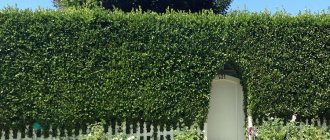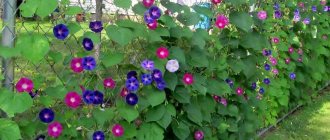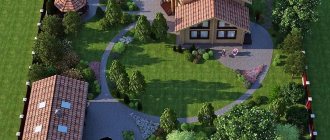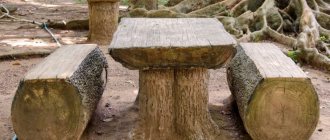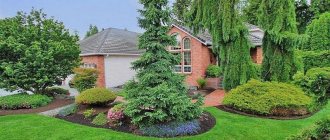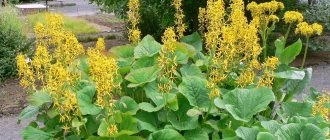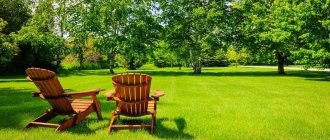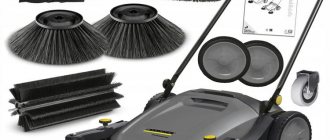My first conifer, bought for the room, has dried up. Watering, fertilizing - nothing helped. The tree has withered. If I knew the specifics of growing conifers indoors, my first tree would already be a meter tall.
Now I have about ten coniferous indoor plants on my windowsill and glassed-in balcony. I'll tell you how to grow them from purchased coniferous mix.
What is pine mix
The coniferous mix is a container with several small conifers - small pines, spruces, junipers, cypresses.
The height of the plants in the mix does not exceed 15-20 cm, the age is about a year. Each plant is placed in its own cell. It can be painlessly transplanted with a lump of earth to a permanent place or into an indoor container-pot.
There are coniferous mixes for open ground and indoor growing.
A list of plants may be indicated on the packaging. However, such a list is not always provided. Therefore, I will characterize the most popular conifers - indoor and outdoor. So that you can figure out what you purchased under the “pine mix” label.
Botanical certificate
Experts categorically object to the current situation, when coniferous plants, due to widespread habit, are called “conifers.” According to the botanical classification, they are representatives of different classes that are included in the Gymnosperms department.
So, the conifers include the well-known spruce, pine, fir, larch, juniper, cypress, thuja, yew, etc. , and among the Gnetaceae (Temenaceae) the order Ephedra stands out, the prominent representative of which is ephedra or double-spike conifer, colloquially also called “Kuzmicheva grass” and “Steppe raspberry”.
More than 60 species of ephedra are known, which grow in southern Europe, Western Siberia, Asia, Kazakhstan, China on the slopes of hills, mountains, and among stones. In many regions the plant has conservation status. The fact is that many types of ephedra contain the alkaloid ephedrine, which has an effect similar to adrenaline. The drugs methamphetamine and ephedrone are produced from ephedrine.
Since 2004, the plant has been included in the list of those prohibited by the Government of the Russian Federation for cultivation in large and especially large sizes. In the case of ephedra, a large fine will be issued if more than 10 specimens are found on the site. But this beautiful shrub is an excellent component of the alpine hill; its fruits are edible both fresh and processed (jam, preserves), and contain only residual traces of ephedrine.
The juicy cone berries are similar to multi-drupe raspberries - hence the name “Steppe raspberry”. The plant is not a conifer
The plant has been known since ancient times. Tribes and nationalities inhabiting the areas where conifers grow used them for ritual ceremonies.
In China, Chinese ephedra, called “yellow hemp,” was used for medicinal purposes.
In Russia, at the end of the 19th century, a peasant from the Samara province, Fyodor Kuzmich Mukhovnikov, treated rheumatism, digestive disorders, and bronchopulmonary diseases with ephedra decoctions. In his honor, the plant began to be called “Kuzmicheva grass” among the people.
“Ephedra two-spikelet” is not at all similar to representatives of Conifers. Gray-green shoots extend from the shortened woody stem, reaching a height of 30-50 cm. The leaves are reduced. The fruits are juicy cone berries (false berries), which birds feed on, which contributes to the spread of the species.
Coniferous mix for the room
Indoor conifers are coniferous plants that are not adapted to wintering outside and low temperatures. Their homeland is often subtropical. In our conditions, they do not tolerate cold winters, so they are grown in greenhouses or on window sills.
Dwarf and creeping varieties are suitable for home growing on a windowsill. They require certain maintenance conditions, compliance with planting and care rules. Namely - fresh humid air, watering, drainage, average illumination.
Indoor conifers include cypress and home cypress, Japanese cedar, indoor spruce and arborvitae.
Cypress and indoor cypress
These two plants differ in the color of their needles. Cypress - has light green needles. Home cypress – dark green. The needles of young plants are needle-shaped. With age, the needles become scaly.
Unlike many other conifers, cypress grows on sunny windowsills. It does not like dry air, so if there is a hot radiator under the window, you need to spray the plant several times a day.
Does not tolerate movements and even turns in one place.
Therefore, it is better not to “rotate” the cypress tree, but to grow it stationary. And replant less often, only if the plant has really grown and does not fit in the old container.
In the summer, you can move the cypress tree outside, into partial shade, given that the plant does not tolerate temperatures above +25°C. In summer it can be watered abundantly. It must be brought into the room no later than the temperature drops below +10°C.
Japanese cedar or Cryptomeria japonica
This small tree is very decorative. Its young needles are flat and soft to the touch. With age, the needles will become awl-shaped and stiffer.
In autumn, Japanese cedar will change the color of its needles - they will turn reddish. This is a signal that the plant is expecting winter.
Japanese cedar grows and develops well if its temperature is reduced in winter, the container is moved to a cool windowsill, or moved to a cooler room.
It loves moisture very much, so daily watering and spraying are required.
It is demanding on the nutritional value of the soil, so every year the soil is partially changed - the top layer is removed and new, fresh soil is added.
Tuevik or tuyopsis
The needles of the thuevika look like a small, leathery, flattened leaf. Loves shade and coolness, grows well in diffused lighting of the corridor.
Araucaria or indoor spruce
The decorative effect of this tree is ensured by its pyramidal crown, which is formed even when grown in an indoor pot. The needles are short, rather rigid, triangular at the base. Winter temperatures should not rise above +16 °C. In summer – up to +25°С.
The plant does not like direct sunlight. Therefore, in summer it is placed outdoors in the shade, and in winter – away from the window. It grows well even in a dimly lit corridor. Does not tolerate dry air, requires spraying. Loves spacious containers and does not grow well in cramped pots.
Thuya Danika
Thuja Danika owes its unusual beauty to its slender trunk and small leaves of bright green color. The plant is used for alleys and hedges. You can plant a thuja in a rock garden, and it will become a color accent to any composition of subdued tones.
The shrub reaches a height of 80 cm, and the diameter of the crown is about a meter. Danica does not grow particularly quickly, which is quite convenient for a small area. Its needles do not require special care. An interesting feature: the leaf cover of the bush changes color in the cold season, becoming almost brown.
Thuja Danica is frost-resistant and grows well in poor soils. It is better to fertilize the soil before planting, and lighten heavy soil by adding drainage materials.
Domestic conifers: conditions of detention
Almost all domestic conifers have similar requirements for living conditions:
- Average illumination. Coniferous plants do not like direct sunlight, but love diffused light. They feel good on northern window sills and grow well in corridors.
- Temperature. Conifers do not like heat; they must be kept at temperatures no higher than +25°C, otherwise the needles turn yellow. In summer, outdoor plants in containers are placed only in the shade. In winter, conifers lower the air temperature to +10 +16°C.
- Watering. Coniferous plants love moist soil, but do not tolerate stagnation. Therefore, watering in summer is daily. In winter - every other day. Drainage is a must. They also love moist air. Therefore, when grown indoors, they respond well to daily spraying. If the room has dry air, they may turn yellow.
- The soil. In nature, conifers grow on soils with average fertility. Therefore, when grown in a room, similar conditions are created for them. The soil mixture is prepared from turf, a small amount of humus and sand in a ratio of 2:1:1 (soil: humus: sand). The substrate reaction should be slightly acidic, within the pH range of 5.5 - 6.5. You can use a special soil mixture suitable for conifers. For example, “Cypress tree”.
- Fertilizer. Conifers do not need large amounts of fertilizer. It is enough to add them once a year, in the summer. It is better to use special fertilizer for coniferous plants. Note: when applying, keep in mind that almost all coniferous complexes are designed for open ground. For house plants, it is necessary to reduce the recommended concentrations by half.
And one more thing: like other outdoor conifers, indoor plants respond well to pruning. They form a thick, beautiful crown.
Landing rules
The rules for planting plants are not complicated. The planning stage requires serious preparation, since the flower garden will be perennial. It is necessary to clearly consider the planting scheme, using a ready-made one or your own, and determine the location on the site. Depending on whether it will be sunny or shaded, select varieties, purchase seedlings, stones, bedding.
In order to correctly place each of the species, you need to read about them in advance, find out the metric characteristics (height, width) of an adult plant, requirements for environmental conditions and agricultural technology.
If the final width of the thuja is 1 m, then when planting the distance to neighboring plants should be at least 0.5 m on each side
Before starting to dig holes, designers advise placing the purchased seedlings on the ground in accordance with the chosen pattern and assessing the location from different sides.
Many gardeners, believing that conifers grow slowly, plant everything very densely. As they grow, such plantings become denser, lose their decorative properties, and are more likely to suffer from diseases. Don't be afraid of empty spaces in the flowerbed. They can be decorated with large stones, hummocks of sedge, bright clumps of profusely and long-flowering annuals: alyssum, lobelia, thin-leaved marigolds, ever-flowering begonia.
Almost all conifers are undemanding in terms of soil type, fertility, and composition, but it is still better to add peat, sand, and compost when digging. At the bottom of the planting holes (for trees their depth is at least 50 cm) a drainage layer is poured - sand, pebbles, expanded clay. The seedling is carefully transferred from the container and lowered into the hole. Cover with earth, carefully compacting it with your hand so that there are no voids.
Experts recommend buying coniferous seedlings only from ZKS. When transshipping them, it is important to prevent damage to the earthen clod.
The plantings are watered abundantly, the ground is immediately mulched with bark, pebbles, and small cones collected from the pine forest.
Coniferous mix for the street
The most popular coniferous plants for outdoors, which can be part of a German or Dutch mix, are pines, spruces, thujas, and junipers. Since the coniferous mix comes from Germany or Holland, the plant varieties are often not intended for long, cold wintering.
The cold in Europe is short and mild, winter is mild. This must be taken into account when transplanting. Coniferous mix in open ground will overwinter well in the southern regions. In the middle zone, it is necessary to cover plants during winter frosts.
Among the street conifers there are light- and shade-loving ones. For example, thuja, pine, juniper love the sun. Yew - grows well in the shade.
Almost all young coniferous seedlings require shading in the first years. They cannot tolerate open, bright sun. In the southern regions, during the first two years, during the hot months, they are covered from above with canopies. In the third year, the canopies are made of lattice. On the fourth and fifth, you can do without an artificial “roof”.
I will describe the most popular varieties of conifers.
Junipers
There are more than ten species of junipers, which have different crown shapes, trunk heights, and needle structures. Among the junipers there are shrubs and trees with a pyramidal and spreading crown. The most common:
- Creeping junipers are spreading shrubs with needles of different colors. There are green, yellowish, bluish varieties. Frost-resistant and drought-resistant.
- Rock juniper – bluish needles, pyramidal shape.
- Juniper virginiana - bluish needles, compact elongated crown, sun-loving and drought-resistant.
Bush junipers are often planted as hedges. Tree-like - in the form of separate garden accents.
Mountain pines
Often formed as a shrub with a spherical crown. They winter well and tolerate drought. When planting, they are planted in a shallow hole, the bottom of which is first filled with stones. Next, the roots are pressed down with small stones, on top of which earth is poured and water is poured.
These plants look good in rock gardens. Suitable for decorating lawns.
Blue spruces
They are often dropped off at the main entrance to the house. In this case, the closest distance between neighboring spruce trees is at least 3 m.
In order for the trees to grow high, they are provided with nutritious, acidified soil. The best soil for spruce seedlings is turf from a spruce or other coniferous forest.
For good growth, prepare a hole 60-70 cm deep. The bottom of the hole is lined with stone, which serves as drainage. After planting, the roots are covered with spruce turf.
Advantages and basic tenets of a mixed flower bed
Evergreens are beautiful all year round and require little care. The flower beds in which they grow are called “beds for the lazy” - after all, the main effort has to be spent at the creation stage, when you need to think about the location, composition and layout, purchase seedlings, stones, mulch, and plant correctly. Further care is minimal.
Conifers are also very useful: they secrete phytoncides - volatile substances that can suppress the development of viruses, bacteria, and pathogenic fungi.
Spruce, thuja, and cypress trees planted along the boundaries of the site have a unique resinous aroma and reliably protect from wind, dust, and pollution.
Creating a flower garden with various types of coniferous trees and shrubs requires compliance with certain rules :
- A game of contrasts - neighboring plants should contrast in size, shape, color.
- Priority to compact, low-growing varieties.
- Mandatory consideration of the final size and characteristics of an adult plant.
- The principle of layering - tall forms are given a place in the back row, on the edge or center, in front of them are placed plants of the second tier and low-growing ground cover plants.
- Careful selection of the entire composition - you need to think through the combination and arrangement of different types of conifers, ornamental shrubs, flowering and herbaceous perennials, and annual crops.
- Attention to design - stones are considered, if not mandatory, then a desirable element; a flower bed with conifers looks good on a well-groomed lawn.
- Decorating/mulching the soil surface between plants.
The principles of tiering and contrast do not separate, but unite the participants of a mixed flower bed into a harmonious ensemble
Fir Icebricker
Icebreaker fir is a relatively new variety. The crown of the tree grows up to 1.2 m in width and resembles a lush volumetric pillow. At the same time, the height of the conifer is only 0.8 m. Sometimes leading shoots appear on mature trees, which form a multi-stemmed crown.
The fir needles are rich green, and the bottom has a silvery-white hue, soft to the touch. Its beams are twisted in such a way that the lower surface becomes immediately visible to the observer. This coloring does not go unnoticed by landscape designers: fir is gladly used in rockery compositions and in open areas next to low perennials.
